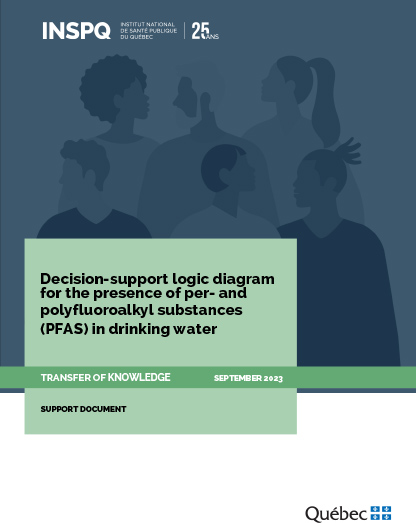Decision-support logic diagram for the presence of per- and polyfluoroalkyl substances (PFAS) in drinking water
Perfluoroalkyl and polyfluoroalkyl substances (PFAS) form a complex group of chemicals comprising thousands of fluorinated organic compounds1 . PFAS arise exclusively from human activity and are used in a wide variety of consumer products and industrial processes. They are highly persistent and ubiquitous in the environment, often in the form of variable mixtures of several compounds. Given the toxic effects that have been associated with certain PFAS, and the current uncertainties concerning exposure levels that present a risk to human health, a number of international initiatives are aimed at banning or restricting the use of these substances in order to reduce population exposure. Moreover, local or point source contamination can add to this diffuse PFAS pollution and reach groundwater and surface water used as a drinking water supply. In some such cases, depending on the extent of contamination, drinking water can represent a significant source of exposure, as compared with diet.
In Québec, there are currently no standards regulating the presence of PFAS in water. However, a growing number of health organizations and jurisdictions around the world are proposing guideline values2 for PFAS, some of which are solely health-based (health-based guideline values), while others take into account various application constraints (management-based guideline values). Guideline values have been determined for certain individual PFAS, while others apply to groups comprising varying numbers of PFAS. Increased attention has recently been focused on the presence of PFAS in drinking water, in light of the significant lowering of guideline values proposed by certain health organizations. Indeed, studies suggest that PFAS may be toxic to humans at doses similar to those resulting from some environmental exposures that were previously considered to have no significant effect. For example, government agencies have recently used epidemiological data related to effects on the immune system to determine toxicological reference values and health-based guideline values for drinking water (4,5). These values are generally very low, and alter the interpretation of the risk associated with exposure to PFAS in drinking water, such that it differs from what was generally assumed until very recently. Finally, the World Health Organization (WHO) and Health Canada recommend keeping concentrations in drinking water “as low as reasonably achievable” (6,7).
The lack of data on the toxicity of many compounds, the presence of mixtures of varying composition of individual PFAS molecules and the rapid evolution of scientific knowledge on the subject add to the complexity of the context outlined above. This is why stakeholders face many challenges in assessing and managing the risks arising from the presence of PFAS in drinking water. The decision-support logic diagram presented here is a tool designed to support the initial management of such a situation, with the aim of rapidly identifying situations where it is desirable to structure public health actions. It proposes benchmarks for both chronic and sub-chronic exposures, as well as for some individual PFAS and for the sum of PFAS.
In all cases, decisions concerning the management of health risks associated with PFAS contamination of drinking water should be carefully examined, in conjunction with the stakeholders involved and with consideration for the anticipated risks and the particularities of each issue identified. Communication-related issues and ethical concerns surrounding risks should also be considered by the responsible authorities.
This document first presents the scientific bases underpinning the PFAS Logic Diagram. It then describes the logic diagram’s structure and positions it within the context of existing risk management documents in Québec. Finally, the document presents the strengths and limitations of the logic diagram, before concluding with a brief discussion of its scope of application.
1As defined by the Organisation for Economic Co-operation and Development (OECD) (3), the common characteristic of PFAS is that they consist of a carbon chain containing at least one fully fluorinated saturated methyl or methylene group. Various functional groups can be added to this fluorocarbon backbone, giving these molecules distinct physical, chemical and toxicological properties.
2Terms highlighted in the text are defined in the glossary at the beginning of this document (p. IV).


